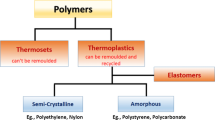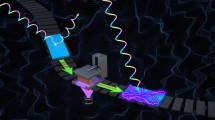A mathematical model for calculating the temperature field in a semitransparent composite material that includes a polymethyl methacrylate matrix and quartz microspheres is suggested. In calculating the optical properties of the composite material, use was made of the optical properties of the matrix and of the interacting quartz microspheres at different filling factors which characterize the volume concentration of particles in the matrix. Allowance for the interaction between the composite components is made following the Maxwell–Garnett approximation. Data on the complex refractive index of the composite were used for calculating the coefficients of absorption, scattering, and attenuation of packed particles by the Mie theory. The temperature fields in a layer of the material are found from solving the boundary-value problem for the energy equation and a system of radiation transfer equations with the use of these coefficients.
Similar content being viewed by others
References
D. Deimerdzhan, Scattering of Electromagnetic Radiation by Spherical Polydisperse Particles [Russian translation], Mir, Moscow (1971).
T. P. Ryzhkova and L. I. Ryzhkov, Application of diffraction theory to thermal radiation transfer, Prom. Teplotekh., 5, No. 4, 26–34 (1983).
Yu. I. Petrov, Physics of Small Particles [in Russian], Nauka, Moscow (1982).
A. G. Blokh, Thermal Radiation in Boiler Plants [in Russian], Énergiya, Moscow (1967).
A. L. Burka and E. V. Velikanov, Nonstationary radiative–conductive heat transfer in a semitransparent medium with account for scattering, Polzunovskii Vestn., No. 1, 24–48 (2004).
M. L. German and P. S. Grinchuk, Mathematical model for calculating the heat-protection properties of the composite coating “ceramic microspheres–binder,” Inzh.-Fiz. Zh., 75, No. 6, 43–53 (2002).
Yu. V. Polezhaev and F. B. Yurevich, Thermal Shielding [in Russian], Énergiya, Moscow (1976).
L. V. Kantorovich, Concerning the Newton method, Tr. Matem. Inst. AN SSSR, 28, 135–139 (1949).
M. M. Gurevich, É. F. Itsko, and M. M. Seredenko, Optical Properties of Paint Coatings [in Russian], Khimiya, Leningrad (1984).
V. M. Zolotarev, V. N. Morozov, and E. V. Smirnova, Optical Constants of Natural and Technical Media [in Russian], Khimiya, Leningrad (1984).
Author information
Authors and Affiliations
Corresponding author
Additional information
Translated from Inzhenerno-Fizicheskii Zhurnal, Vol. 85, No. 1, pp. 151–157, January–February, 2012.
Rights and permissions
About this article
Cite this article
Burka, A.L., Emel’yanov, A.A. Radiative-conductive heat transfer in a semitransparent composite with microspherical particles. J Eng Phys Thermophy 85, 162–168 (2012). https://doi.org/10.1007/s10891-012-0634-9
Received:
Revised:
Published:
Issue Date:
DOI: https://doi.org/10.1007/s10891-012-0634-9




